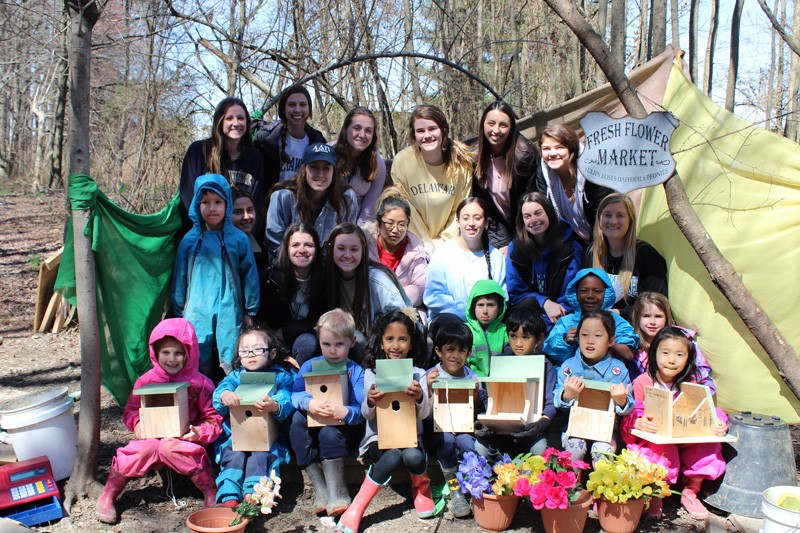Early childhood education and engineering majors collaborate to build bird nesting boxes
On a chilly morning recently at the University of Delaware’s Children’s Campus, a few dozen children — guided by undergraduates — took hold of screwdrivers to build nesting boxes for local native birds.
Sponsored by the College of Education and Human Development and the College of Engineering, the project is part of a nationwide monitoring program called NestWatch, which crowdsources information about bird reproduction — including nesting dates, number of eggs laid, hatched and how many hatchlings survive — to better understand how bird populations are changing over time as a result of climate change and loss of natural habitats due to urban sprawl.

A child works on a birdhouse as part of a program in which College of Education and Human Development students and faculty collaborate with College of Engineering students and faculty to help children learn about birds
‘Resident Ornithologists’
Working with Early Childhood Education (ECE) majors, who were taking part in the project as part of a class called, Early Childhood Inclusive Science Curriculum and Assessment (HDFS 413), pre-K and kindergarten students learned about various species of birds, their size, nesting place preferences, space needed between nests, wood preferences for a house and size of house needed based on the unique needs of each species. Children also observed birds and learned to identify the particular call of each species.
The ECE majors collaborated with master teachers at The Laboratory Preschool and The College School, both located on UD’s Children’s Campus, to develop the curriculum. According to Katie Pollock, master teacher at The Laboratory School, these kinds of activities encourage children to be more aware of the relationships that exist among all living things.
“The children have become our resident ornithologists,” said Pollock. “Every morning, we greet the birds during our morning meeting and they say hello back. Helping children to be conscious of all creatures — large, small, feathered, and furry — is one of our missions at the Nature Preschool.”
“It’s wonderful that our undergraduates can take an active role in shaping curriculum,” said Jennifer Gallo-Fox, assistant professor in the Department of Human Development and Family Sciences. “Not only does this project provide undergraduates with an engaging teaching experience, but these experiences make a meaningful contribution to the Laboratory School’s program while also providing foundational learning opportunities that will support their work in future classrooms.”
Engineering Partnership
In addition to teaching children about the role of birds in our natural environment, the project is an opportunity for ECE majors to learn about engineering principles and participate in constructing an outdoor learning environment.
To prepare for the project, 33 ECE majors attended workshops in the mechanical engineering Design Studio with associate professor Jenni Buckley, teaching assistants Erin Rezich and Pete VanderKley, as well as Design Studio co-director Whitney Sample, who trained them on basic hand and power tool operation and then worked with them directly to create the bird houses.
“The College of Engineering, and in particular, the Department of Mechanical Engineering, is committed to giving back to our local community, and this definitely includes our pre-K through grade 12 teacher partners,” said Buckley. “The more comfortable teachers are with engineering and hands-on skills, the more they will be comfortable encouraging students to pursue majors like ours. It benefits the entire engineering community, particularly in terms of diversity and inclusion, to involve teachers in engineering projects.”
By the end of the project, the team had assembled 23 nesting houses that will attract 13 different species of local native birds known to live in the natural habitat around the Children’s Campus, which include Black capped chickadee, Carolina chickadee, Tufted titmice, Prothonotary warbler, White-breasted nuthatch, Eastern bluebird, Tree swallow, Carolina wren, Northern flicker, American Robin, Barn swallow and Wood duck.
The nesting boxes are now a permanent part of the outdoor classroom at the Children’s Campus and will support continued study of birds and their nesting habits during academic-year and summer camp programming.
The children visit the houses weekly to check for new residents. As of this week, Carolina wrens, House wrens and Tree swallows have begun nesting.


